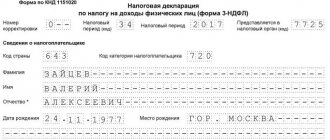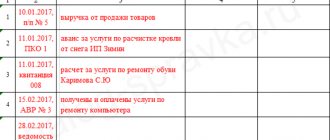The Tax Code of the Russian Federation does not contain the concept of “zero reporting,” but most often it means a declaration with zero indicators for activities as a whole or for the amount of tax payable. Depending on the situation in which the declaration is filled out, there are:
- Reporting with zero indicators for all activities (lack of income and expenses, amount of tax payable to the budget). This document is submitted by entrepreneurs who do not actually carry out activities in the reporting or tax period.
- Reporting with a “zero” amount of tax payable (when the amount of tax payable is reduced entirely by the amount of expenses).
The type of zero declaration, its form and the procedure for reflecting information in it depend on the taxation regime.
As a rule, a regular declaration is submitted for the selected taxation regime, but in some cases, an entrepreneur can submit a single simplified declaration (SUD) instead of a zero declaration. At its core, this document can also be classified as zero reporting, since it does not contain any information about income and expense transactions and is presented only in the event of a complete suspension of the activities of the individual entrepreneur and the absence of any tax transactions in respect of which it is presented. Let's consider in more detail how to fill out a zero declaration for individual entrepreneurs in each of the taxation regimes, including the EUD.
Who submits a single simplified declaration
The possibility of filing a special tax report - a single (simplified) tax return - is indicated by clause 2 of Art. 80 Tax Code of the Russian Federation. It is permitted to use this document instead of regular declarations if the taxpayer (legal entity or individual entrepreneur) did not conduct business activities during the reporting period.
In other words, if he didn't have:
- cash flows;
- taxable objects.
In this case, the taxpayer must have the obligation to submit tax reports, even if they are generated with zero indicators (and such an obligation, in the absence of an object subject to taxation, does not arise for all taxes).
Another condition limiting the possibility of using the EUD is that specified in paragraph 2 of Art. 80 of the Tax Code of the Russian Federation, the frequency of its submission is after each period ending at the end of the next quarter, which makes this document inapplicable to taxes for which monthly reporting is established by law.
Penalties for failure to submit VAT tax
For late submission of a VAT report, you are subject to a fine of 5% of the amount not paid on time for each full and partial month of delay. The maximum fine is 30%, the minimum is 1,000 rubles (Article 119 of the Tax Code of the Russian Federation). Officials may receive a warning or a fine of 300–500 rubles.
Incorrectly submitting the EUD instead of a zero according to the simplified tax system will lead to the same consequences. You will avoid liability if you submit an updated return before the tax office finds a violation. In such a situation, the EUD is considered primary, and the VAT return is considered updated. Therefore, the report will not be considered submitted late. Please indicate the adjustment number on the title page of your VAT return. This way you will record that you are submitting clarifications.
Keep VAT records in the Kontur.Accounting web service. Regularly enter transactions into the system in order to receive an automatically completed declaration at the end of the reporting period. Accounting also helps to maintain accounting and tax records, pay employees, submit reports via the Internet and keep abreast of all changes. New users receive 14 days of use of the service as a gift.
What taxes does the EUD replace?
Based on the above restrictions, the following taxes should be included in a single declaration:
- the obligation to submit a report on which is not canceled by the fact that there is no taxable object;
- with a reporting frequency that is a multiple of a quarter (it can be equal to a quarter, half a year, 9 months and a year).
Those that meet both conditions simultaneously include:
- income tax - with reporting generated on an accrual basis on a quarterly basis;
- VAT - a report on it is compiled based on the results of each past quarter;
- simplified tax system - here the report is generated once at the end of the year;
- Unified Agricultural Tax - it also requires drawing up 1 report at the end of the year.
What form should I use to submit the EUD for 2019?
The form on which the EUD-2019 will be generated is approved by Order of the Ministry of Finance of the Russian Federation dated July 10, 2007 No. 62n. And the same document reflects the procedure used when preparing the declaration.
EUD form for 2021
Since the form of the form has not changed since its approval, the OKATO code is indicated as a code reflecting the territorial affiliation of the reporting entity. The Federal Tax Service of Russia recommends entering the OKTMO code in the field provided for it (Letter No. ED-4-3/18585 dated October 17, 2013).
Features of registration and delivery of EUD in 2019
The advantages of the EUD in comparison with conventional declarations are:
- the ability to reflect data on several taxes at once and in relation to tax periods of varying lengths;
- it is not necessary to apply an electronic method of presentation to it.
But a single declaration must be submitted no later than the 20th day of the month following the end of the reporting period (clause 2 of Article 80 of the Tax Code of the Russian Federation) - significantly earlier than the deadlines established for the submission of regular tax returns reflected in the Unified Tax Code.
Because of this, the EUD is rarely used for taxes on the simplified tax system and unified agricultural tax, for which reporting is submitted one-time at the end of the year.
Using them, it is easier to generate a regular declaration with zero indicators and submit it at a much later date (before March 31 - for organizations, and if we are talking about individual entrepreneurs reporting on the simplified tax system, then even later - before April 30).
Deadlines and format of delivery
The EUD is submitted quarterly, but the time allocated for its preparation is slightly less than for the VAT return. The due date is the 20th day of the month following the expired reporting period. If it is a weekend or holiday, delivery is postponed to the next working day. In 2021 the deadlines are as follows:
- for the fourth quarter of 2021 - January 20, 2021;
- for the first quarter of 2021 - April 20, 2021;
- for the second quarter of 2021 - July 20, 2021;
- for the third quarter of 2021 - October 20, 2021;
- for the fourth quarter of 2021 - January 20, 2022.
The report must be submitted to the Federal Tax Service at the location of the company or place of residence of the entrepreneur. Unlike the VAT return, you can submit the EUD either electronically or on paper. If the average headcount for the previous year is more than 100 people, only electronic format is available. Newly created organizations count the average number of employees in the month of their creation.
The procedure for filling out a single simplified declaration 2021
The basic rules for filling out the EUD are presented in the table:
| Report fields | How to apply |
| TIN | TIN is filled out by both individual entrepreneurs and organizations. We enter it from left to right. Organizations put dashes in the last two empty cells |
| checkpoint | Fill in only organizations, individual entrepreneurs put dashes here |
| Document type | When submitting the report for the first time, put “1”; when submitting an update, put “3” (and indicate the correction number through the fraction) |
| Reporting year | The year for which we submit the report (in our example - 2019) |
| Federal Tax Service Authority | Code and full name of the Federal Tax Service to which the EUD 2019 is submitted |
| Name of company | The name of the reporting organization in accordance with the constituent documents. Individual entrepreneurs indicate their full name. in full (middle name - if any) |
| OKATO | OKTMO code by classifier |
| OKVED 2 | Type of economic activity of the reporting organization (IP) in accordance with the extract from the Unified State Register of Legal Entities (USRIP) |
| Taxes | Names of taxes for which the EUD is submitted. If you report on several taxes, reflect them in the order in which they appear in the Tax Code of the Russian Federation |
| Chapter number | Number of the head of the Tax Code of the Russian Federation regulating the tax |
| Tax period and quarter number | The coding depends on the tax reporting period for which the report is submitted. For taxes with a tax period of “quarter”, enter code “3” in column 3 (period). In this case, in column 4 (quarter) indicate:
For taxes with a tax period of “year” in column 3 enter:
In this case, column 4 is not filled in |
| Phone number | Contact telephone number for contacting the taxpayer in the format +74954658412 ("+" sign, country code, number) |
| Number of sheets | Number of pages in the report |
How to fill out and submit a zero VAT return
A zero VAT return assumes that the taxpayer does not have the data to fill out sections 2-12. Therefore, only the title page and section 1 are included in it. The report form for the fourth quarter of 2020 and for future periods was approved by Order of the Federal Tax Service dated August 19, 2020 No. ED-7-3 / [email protected] The same document describes the procedure for filling out
Let's look at the peculiarities of filling out and returning the zero.
Title page
The title page is filled out in the standard manner. Follow the instructions:
- Please indicate your tax identification number and checkpoint in the header of the report.
- Indicate the exact name of the organization or full name for individual entrepreneurs.
- Enter the Federal Tax Service number from the registration documents.
- Fill in the field “at location (accounting)” with the code from Appendix 3 to the Procedure for filling out the declaration.
- Enter the correction number. For the primary declaration - “0”.
- Specify the tax period code by selecting the one you need from Appendix 3 to the Procedure for filling out the declaration. The first quarter is “21”, the second quarter is “22”, the third quarter is “23”, the fourth quarter is “24”.
- Indicate that the declaration will have two pages, since it only includes the title page and the first section.
- Enter information about the person who filled out the declaration and who is responsible for its accuracy.
Sample of filling out the title page
Section 1
There is practically no need to fill out the first section in the zero declaration: enter data in only two lines and leave the rest empty. If you fill out the report on paper, add dashes.
In line 010, enter the OKTMO code. It can be found at the Federal Tax Service or on the Rosstat website. But the easiest way is to use our OKTMO service using TIN.
Enter KBK in line 020. Select the required code in the help desk.
Sample of filling out section 1
Deadlines and format of delivery
Filing a zero tax return is practically no different from filing a regular one. The deadlines, place of delivery and form are the same.
VAT payers submit returns quarterly. In each report, they collect information from the past three months. The due date is the 25th day of the month following the reporting period. If the 25th falls on a weekend, holiday or non-working day, the report is submitted on the next working day. For a zero VAT return, the rules are similar.
Due dates in 2021:
- for the fourth quarter of 2021 - January 25, 2021;
- for the first quarter of 2021 - April 26, 2021;
- for the second quarter of 2021 - July 26, 2021;
- for the third quarter of 2021 - October 25, 2021;
- for the fourth quarter of 2021 - January 25, 2022.
Send the zero declaration to the Federal Tax Service via the Internet. The form of delivery does not depend on the number of employees or the composition of the declaration, that is, zeros are also accepted only in electronic form. If you try to submit a report on paper, the Federal Tax Service will simply not accept it and will consider it not submitted, and for this you may face a fine.
Only those who are exempt from paying or are not tax payers, but generate reports as required by law, can submit a declaration on paper. These are tax agents, importers, companies that issue VAT invoices, etc.
Keep records of exports and imports in the Kontur.Accounting web service. Simple accounting, payroll and reporting in one service
Let's sum it up
- If certain conditions are met, regular tax reporting, generated with zero indicators, for a number of taxes can be replaced with a single simplified declaration, including information on several taxes at once.
- As a rule, the EUD includes income tax and VAT.
- The EUD allows you to reduce the amount of reporting generated during the period of inactivity, but it is required to be submitted earlier than a regular declaration.
- The electronic reporting form for the EUD is not mandatory.
Submission methods
It is possible to submit a single declaration in different ways:
- on paper (in particular, upon personal appearance at the tax authority, and can also be sent through your representative) or by mail;
- In the electronic version, delivery occurs via telecommunication channels.
It is important to note that when submitting a document in paper form, some Federal Tax Service may require the attachment of a declaration file in xml form on a floppy disk or flash drive, and also that a special bar code be printed on the declaration, which will repeat the information reflected in the declaration. Such requirements are not supported by the Tax Code of the Russian Federation, but in reality, failure to comply with them may lead to failure to submit the declaration.
When sending a document by mail, the date of submission is considered to be the date of its sending, which can be determined by the postal stamp.
A declaration sent before 24 hours of the last day of submission is considered to be submitted on time. The envelope must contain a description of the contents. The main problem with postal mail is disputes about the date of dispatch. It is imperative to keep all documents, receipts confirming the sending and delivery of the declaration to the tax office.
If the tax office considers that the declaration sent by mail has not been submitted, then it may block the current account, but not earlier than ten working days after the payment deadline. If the document was provided on time, then to unblock the account you must provide:
- a copy of the declaration;
- inventory of attachments;
- mail receipt or delivery receipt.
Unblocking occurs within 1 business day.
When sending a declaration via telecommunication channels, the date of submission is the date of sending. The Tax Inspectorate approves electronic reporting forms. If an organization submits a declaration electronically, then it is not necessary to provide it on paper, unless the paper version is needed by the organization itself. Enterprises that have more than 100 employees can apply electronically. The average headcount is calculated as follows:
- if the organization has been operating for a long time, then they count for the previous year;
- if the organization is new, then for the month of creation;
- if the organization is reorganized, then for the month of reorganization.
You can submit it electronically through a special operator; for this you must have:
- Internet access;
- agreement with a special operator;
- electronic signature key;
- encryption program;
- program settings.
You can also submit through a website owned by the tax service, using the free program “Legal Taxpayer”, the website of the Federal Tax Service of Russia.
Since 2015, many provisions in the field of property tax legislation have changed. How property tax is calculated according to the new scheme will be discussed in the article.
The formula and examples for calculating labor productivity are presented here.
The state budget is formed from taxes and fees. In this article https://businessmonster.ru/buhuchet/nalogooblozhenie/vidyi-nalogov.html we will consider in detail the taxation system in the Russian Federation. Types of taxes for legal entities and individuals.






